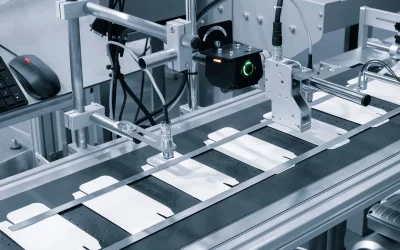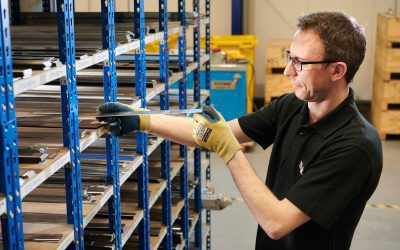What is machine blade edge preparation?
Over time machine blades will dull, chip and generally become blunt and less effective at their primary purpose; cutting.
Edge preparation is the process of removing material along the edges of metal surfaces, with the primary aim of restoring said metal surfaces to their maximum cutting characteristics.
So, if you find that your machine blades are less effective than they were when new, it’s likely that they’ll benefit from edge preparation.
Edge preparation as essential maintenance
The modern packaging, processing and manufacturing industries are highly-competitive, with even the slightest delay or downtime reaping havoc upon production schedules and ultimately, profitability.
So, it’s essential that your machine blades maintain their cutting performance over long life cycles.
The cost of new blades can quickly mount up, particularly if you are reliant on OEM replacements (which, you don’t need to be).
In order to reduce downtime and lower operating costs, we highly recommend factoring edge preparation into your ongoing maintenance schedules (if you haven’t already). By using a high-quality edge preparation service, you can pre-empt blade failure and prolong the life of your machine blades as much as possible.
Edge preparation considerations
Edge preparation is something of a fine art, in addition to being a science.
Why? Because, it’s about balance.
If you want the sharpest possible machine blade, then you’d just regrind it until it has the finest cutting edge.
Sounds good right?
Not necessarily. A blade with the sharpest cutting edge possible may well have excellent cutting properties, but it’ll struggle to withstand much use and abuse. You’d find that it would break in an exceptionally short amount of time.
It’s important to also consider what your machine blades will be cutting. Depending on the material your blades will be interacting with, sharper may not necessarily mean better. In one application, a highly polished, sharp edge may be best. In another application, a rougher finish may result in an improved cut.
So, appropriate edge preparation involves finding the correct balance between cutting performance and durability. It’s a skill which we’ve been perfecting for some time here at MRMK.
What are the benefits of machine blade edge preparation?
As you’ve probably worked out, properly executed edge preparation will have a direct impact on your machine blades, and less indirectly, on your wider operations thanks to increased blade longevity and less downtime.
Quality edge preparation will result in:
- A sharper cutting edge.
- Generally better blade performance.
- Prolonged blade life.
- More uniform cuts.
- Improved longevity.
- Improved efficiency.
- Reduced machine downtime.
- A better-finished product.
These are all, of course, excellent benefits, but for many operators, the key benefit is prolonged blade life.
With proper edge preparation, you maximise the life you get out of your machine blades, reducing replacement costs and maximising your return on investment on your initial blade purchases.
It’s worth noting that longer machine blade life is also matched with improved blade efficiency. By having blades that are properly sharpened, they’ll be operating at their optimal level, creating a more efficient production line.
The long and short of it is this – longer machine blade life can result in significant cost savings for your business.
So, don’t overlook the importance of edge preparation in your overall operations.
What types of edge preparation techniques are there?
Okay, so now that we’ve looked at what edge preparation involves and the benefits associated with it, let’s take a look at the different edge preparation techniques that are most commonly employed on machine blades.
Honing
If you’re looking to achieve a specific bevel or profile on your machine blades, then honing is the ideal edge preparation technique.
It’s a technique which helps produce a more durable and consistent edge to a knife or blade; this is particularly useful for blades that are used in crush cut applications.
Whilst honing doesn’t necessarily provide the sharpest possible blade edge, it has the advantage of creating stronger cutting edges which can withstand significantly high cutting pressures.
Polishing
Should you be looking to attain extremely sharp edges on your machine blades, then polishing should be your go-to edge preparation technique.
Polishing not only creates a sharp edge, but a smooth and consistent one too. This means that knives and blades that have been polished have fewer surface irregularities. This reduces friction and adhesion, thereby producing a cleaner, more consistent cut.
Regrinding
Regrinding is an edge preparation technique which, as the name suggests, involves using grinding tools to reduce the ‘behind the edge’ thickness of a machine blade.
This edge preparation technique therefore improves the cutting geometry of the blade, making it sharper, resulting in cleaner cuts.
Regrinding, by its very nature, does however reduce the material substance of a blade. So, whilst it will renew a blade, a blade can only be reground a certain number of times.
Bevelling
Bevelling involves creating (or renewing) a bevelled edge on a machine blade. It’s a process which can create a much sharper cutting edge.
Think of it this way; the steeper the cutting edge angle (created by bevelling), the sharper the knife. However, this sharpness is achieved by creating a thinner blade cross section. As you can imagine, this can reduce the overall durability and lifespan of a machine blade.
As we mentioned earlier – it’s about finding the correct balance between durability and sharpness.
Highly-quality machine blade grinding from MRMK
If this guide to machine blade edge preparation techniques has got you thinking about your own machine blades, perhaps it’s time to get them checked, renewed and regrinded.
Based in the heart of Sheffield’s world-famous steel industry, MRMK has years of experience regrinding machine blades, completely refurbishing knives and blades so that they are as good as new.
Find out more about MRMK’s regrinding service now
For more machine blade information and advice, explore the MRMK news and insights hub…
When to Replace Your Industrial Machine Blades | The Ultimate Guide to Blade Coatings and Their Benefits | Made in Sheffield: A History of Knife Making and Steel in Sheffield


 +44 (0) 1909 519815
+44 (0) 1909 519815 


